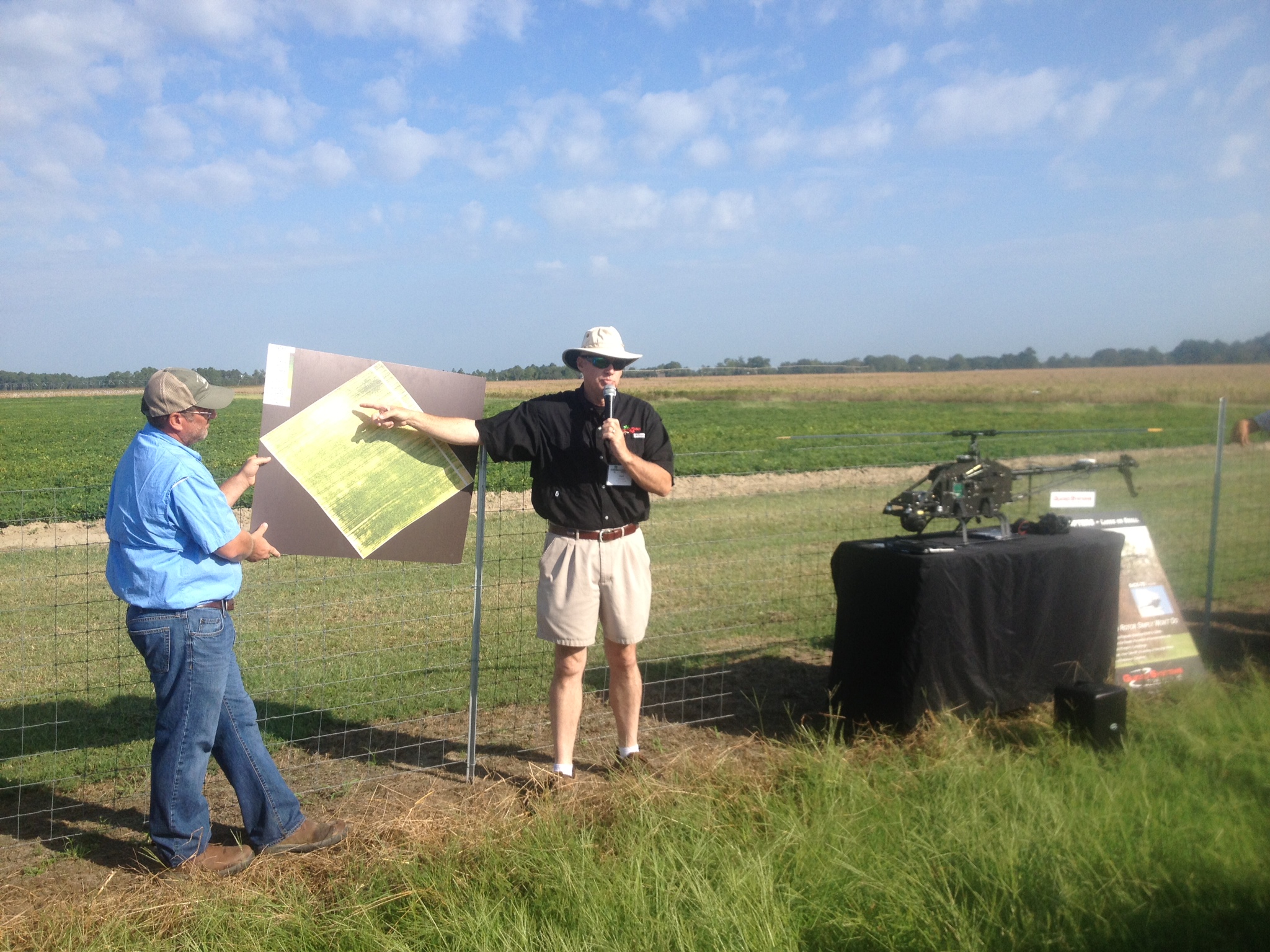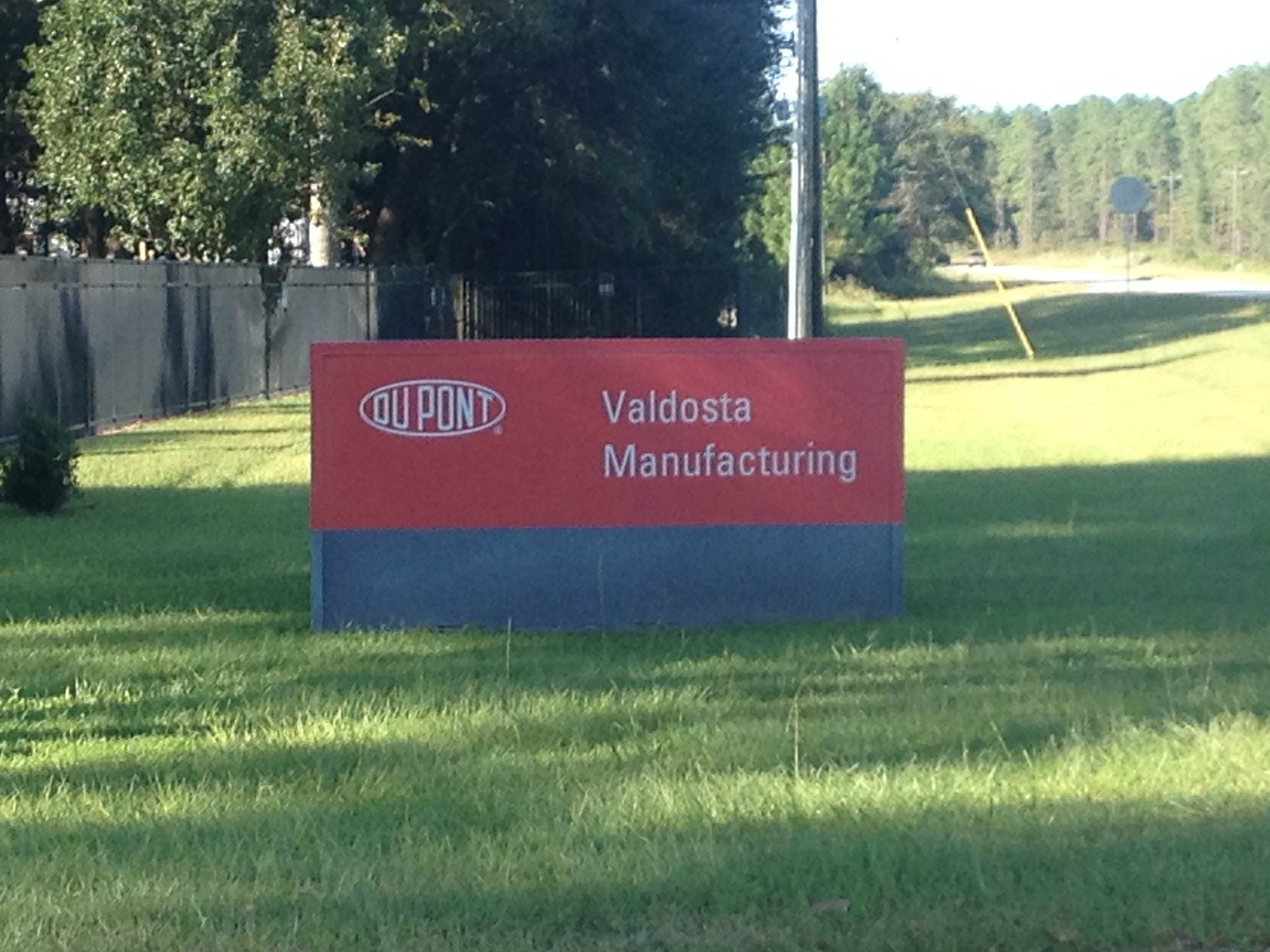 To begin the second day of the 2013 Georgia Peanut Tour, attendees arrived at the DuPont Crop Protection facility in Valdosta, Ga. This particular facility produces crop protection materials such as fungicides for application on peanuts. The tour began in DuPont’s shipping and receiving area where ingredients are brought into the plant and finished products are shipped out. From there, attendees were able to visit the area of the plant where liquid formulation of fungicide takes place. At this particular DuPont plant, the fungicide Fontelis is manufactured. In the formulation room, dry ingredients are added to liquid ingredients and then milled and charged in large tanks. From there, the product travels through pipes to the packaging room where jugs are filled and labeled. In this room, it takes 45 seconds for the machines to fill three cycles worth of jugs. One cycle equals 6 jugs, so that means 18 jugs are filled in 45 seconds. Pretty impressive! To fill 180 gallons (approximately 72 jugs) and send them through packaging, it takes approximately 15 minutes. Employees are able to rely on precise ergonomic equipment that is being used throughout the formulation and packaging process to ensure accuracy and quality. Speaking of quality, DuPont prides itself on several ethical codes; two of them being quality and safety. Quality control and analysis is monitored throughout the entire production process. This includes formulation of the product and packaging of the product. As for safety, DuPont believes safety is important for not only customers of their product, but also for their employees working at the plant.
To begin the second day of the 2013 Georgia Peanut Tour, attendees arrived at the DuPont Crop Protection facility in Valdosta, Ga. This particular facility produces crop protection materials such as fungicides for application on peanuts. The tour began in DuPont’s shipping and receiving area where ingredients are brought into the plant and finished products are shipped out. From there, attendees were able to visit the area of the plant where liquid formulation of fungicide takes place. At this particular DuPont plant, the fungicide Fontelis is manufactured. In the formulation room, dry ingredients are added to liquid ingredients and then milled and charged in large tanks. From there, the product travels through pipes to the packaging room where jugs are filled and labeled. In this room, it takes 45 seconds for the machines to fill three cycles worth of jugs. One cycle equals 6 jugs, so that means 18 jugs are filled in 45 seconds. Pretty impressive! To fill 180 gallons (approximately 72 jugs) and send them through packaging, it takes approximately 15 minutes. Employees are able to rely on precise ergonomic equipment that is being used throughout the formulation and packaging process to ensure accuracy and quality. Speaking of quality, DuPont prides itself on several ethical codes; two of them being quality and safety. Quality control and analysis is monitored throughout the entire production process. This includes formulation of the product and packaging of the product. As for safety, DuPont believes safety is important for not only customers of their product, but also for their employees working at the plant.
Good southern cooking at Carter’s Catfish House
Peanut Tour attendees wrapped up the first day of the tour tonight with some of the South’s finest traditions as they licked their fingers and sipped on sweet tea from Carter’s Catfish House in Adel, Ga. Carter’s Catfish House is locally-owned by Matt Carter who is known for his restaurant’s hospitality.
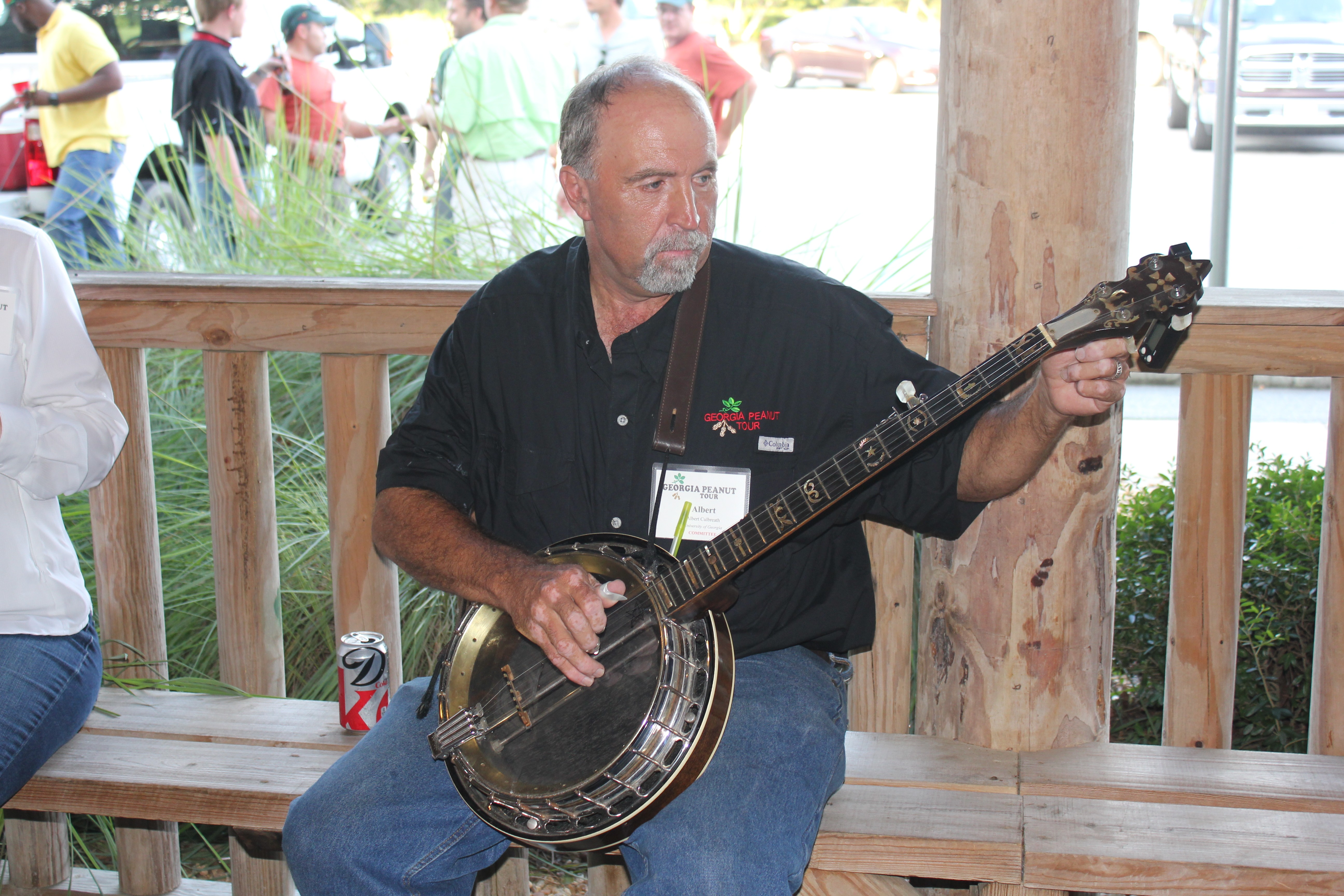 Albert Culbreath, with the University of Georgia, treated us all to some good ol’ pickin’ & grinnin’ before we sat down for supper. Attendees gathered around Culbreath to listen to him play the banjo on the front porch of the Catfish House as they casually drank and socialized.
Albert Culbreath, with the University of Georgia, treated us all to some good ol’ pickin’ & grinnin’ before we sat down for supper. Attendees gathered around Culbreath to listen to him play the banjo on the front porch of the Catfish House as they casually drank and socialized.
Attendee’s were treated to fried chicken, fried catfish, home-style mashed potatoes, green beans… and of course grits. Wait, what’s a full supper without dessert?  Supper was followed-up with some desserts that will make you go “nuts!” Mouthwatering peanut butter pie and nutter butter banana pudding was the talk of the night. After winding down from well-spent evening with good food, attendees will be gearing up for day 2 of the tour tomorrow morning at stop No. 1: DuPont.
Supper was followed-up with some desserts that will make you go “nuts!” Mouthwatering peanut butter pie and nutter butter banana pudding was the talk of the night. After winding down from well-spent evening with good food, attendees will be gearing up for day 2 of the tour tomorrow morning at stop No. 1: DuPont.
Seeds, fertilizers and grades: A tour of the GA Dept. of Ag Lab & FSIS
Peanut season is the busiest time of year for everyone at Georgia Federal- State Inspection Services. Farmers are in demand to have their peanuts graded in time for market. Georgia FSIS inspects over 35 comedies, peanuts being the largest. Peanut Tour attendees had the opportunity to see how the Farmers’ Stock grading procedures work, view grading equipment and the grading process. Teresa Cox, supervisor of District 12, talked about the grade room procedures and the process for grading inspection for peanut seeds. She began by saying once they they obtain their peanut samples, peanuts are first poured onto a grader, which requires a minimum of 1,500 grams of peanuts. 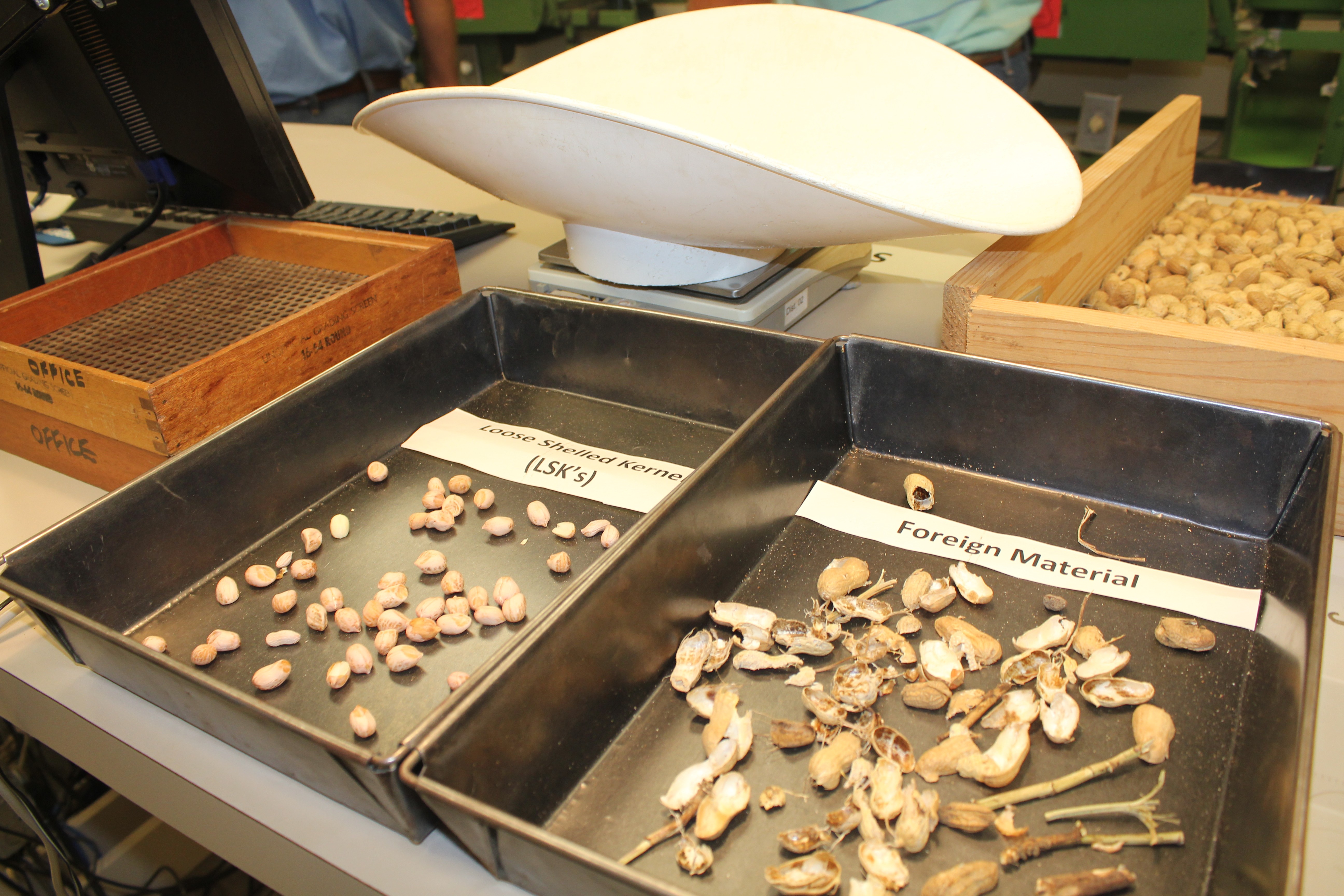 The peanuts then go into a foreign material machine which separates foreign material and LSK (lose shelled kernels). From this point, peanuts are taken from the scales to a pre-sizer, to a sheller and then to a moisture machine. Once the moisture machine has 250 grams, peanuts are then transported to a shaker to get rid of splits or immature kernels. They are then poured into a pan and hand-picked for anything that may have been missed before going through the splitter where they check for concealed damage and Aspergillus flavus mold.
The peanuts then go into a foreign material machine which separates foreign material and LSK (lose shelled kernels). From this point, peanuts are taken from the scales to a pre-sizer, to a sheller and then to a moisture machine. Once the moisture machine has 250 grams, peanuts are then transported to a shaker to get rid of splits or immature kernels. They are then poured into a pan and hand-picked for anything that may have been missed before going through the splitter where they check for concealed damage and Aspergillus flavus mold.
Also at this stop, tour attendees got the chance to visit the Georgia Department of Agricultural Lab in Tifton, where they focused on the seed, fertilizer and feed section. This section administers the rules and regulations related to seeds, fertilizer and feeds by regulating labeling and quality standards for items for sale in Georgia. Mark McMillan, a representative with the Georgia Department of Agriculture, specifically focused on the feed and fertilizer of the tour where he talked about sulfur tests and Inductively Coupled Plasma (ICP), which are tests that determine which elements are in the fertilizers and which are absent. Scott Hobby, representative with the Georgia Department of Agriculture, talked more about the seed portion of the lab. The Georgia Department of Agriculture seed lab tests over 20,000 seeds annually, with 12,000 of them being peanut samples. Farmers have the ability to send seeds to the Department of Agriculture lab and have their seeds tested free of charge. Dee-Dee Smith, a seed analyst, then went over the daily routines of a a seed analyst who separates seed to make labes to go on seed bags before administered to the public. Seeds are separated into kind and variety before sold.
Dr. John Beasley with the University of Georgbia also treated tourist to HOT boiled peanuts donated by Albert Culbreath while they listened to him discuss the differences in the four main variates of peanuts and how to determine maturity in peanuts using a Peanut Profile Board. 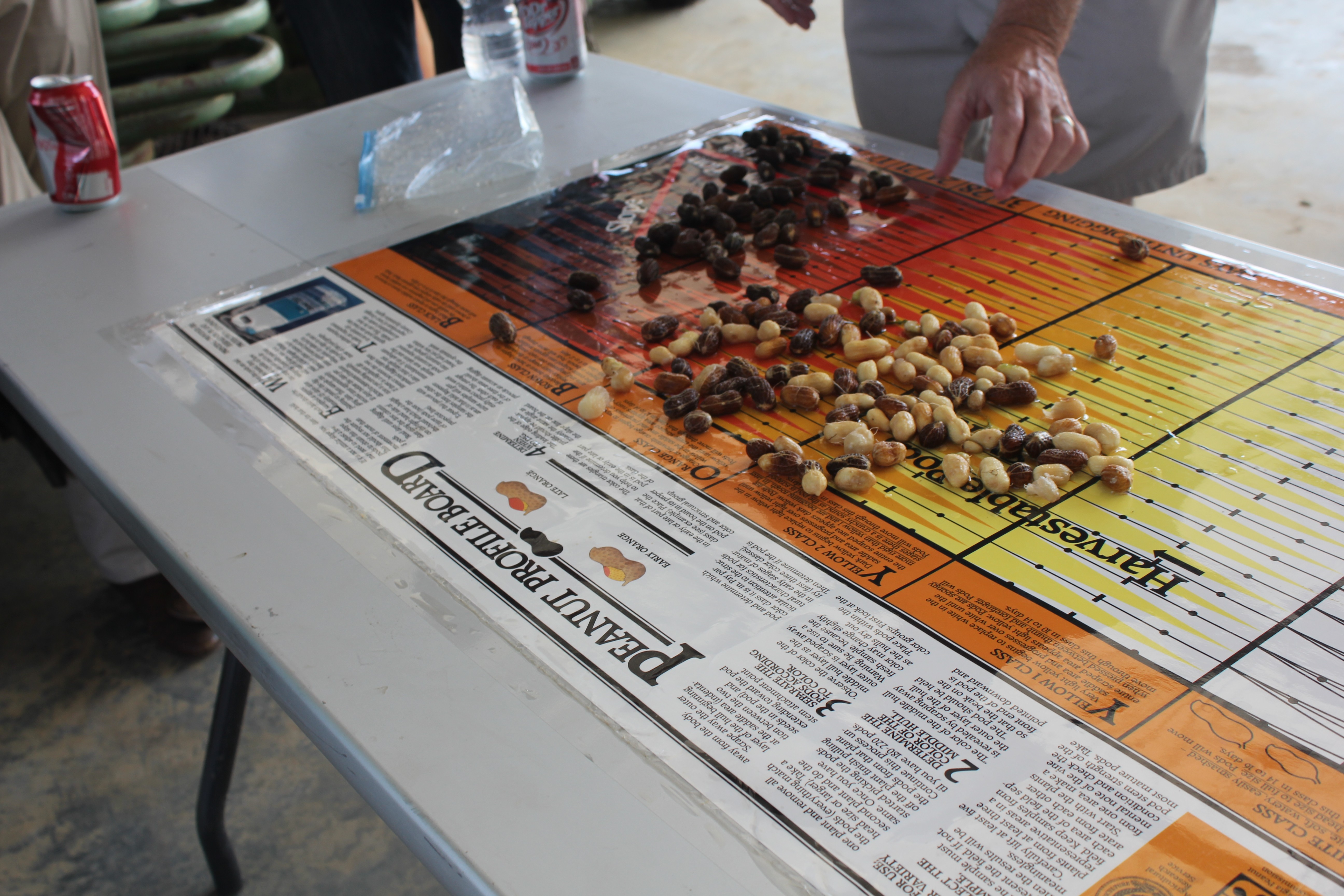 The board is colored coded from lighter colors to darker so researchers and extension agents can separate them via color on the chart to determine the number of days until maturity. Dr. Beasley also discussed the hull-scrape method and other ways to determine the maturity of peanuts and when they are ready to harvest.
The board is colored coded from lighter colors to darker so researchers and extension agents can separate them via color on the chart to determine the number of days until maturity. Dr. Beasley also discussed the hull-scrape method and other ways to determine the maturity of peanuts and when they are ready to harvest.
KMC: Georgia’s own peanut equipment manufacturer
After leaving the University of Georgia’s Gibbs Research Farm, the Peanut Tour caravan headed over to Kelley Manufacturing Co. in Tifton. Kelley Manufacturing Co. is the industry’s leader in developing top-quality peanut harvesting equipment. They have significantly impacted the peanut industry through providing state-of-the-art equipment. KMC employs some of the top engineers and specialists in the manufacturing process with over 180 employees. All products are built in-house at the manufacturing facility located in Tifton, Ga. Each piece of equipment is designed with the farmer’s needs in mind, ensuring a top quality implement that will produce top quality results. During the KMC stop, peanut tour attendees were able to hear more about the history of KMC, participate in a tour of the plant showcasing how the equipment is manufactured, as well as a hands-on tour of peanut equipment! Check out the video below of equipment parts receiving a fresh coat of paint!
Peanut Research at the University of Georgia’s Gibbs Research Farm
Georgia Peanut Tour attendees were able to see some of the ongoing research being conducted at the University of Georgia’s Gibbs Research Farm in Tifton, Ga., on the second stop of the tour. The Gibbs Research Farm is one of the many research farms in Georgia where peanut research takes place. During the stop, attendees were able to hear first-hand where research dollars are being spent and some of the latest research that is being carried out at the Gibbs Farm. Discussion of current issues affecting Georgia’s peanut production, such as the affects of the large amount of rainfall Georgia has received over the last several months and how it may affect crop yield, disease management and pest management were covered. 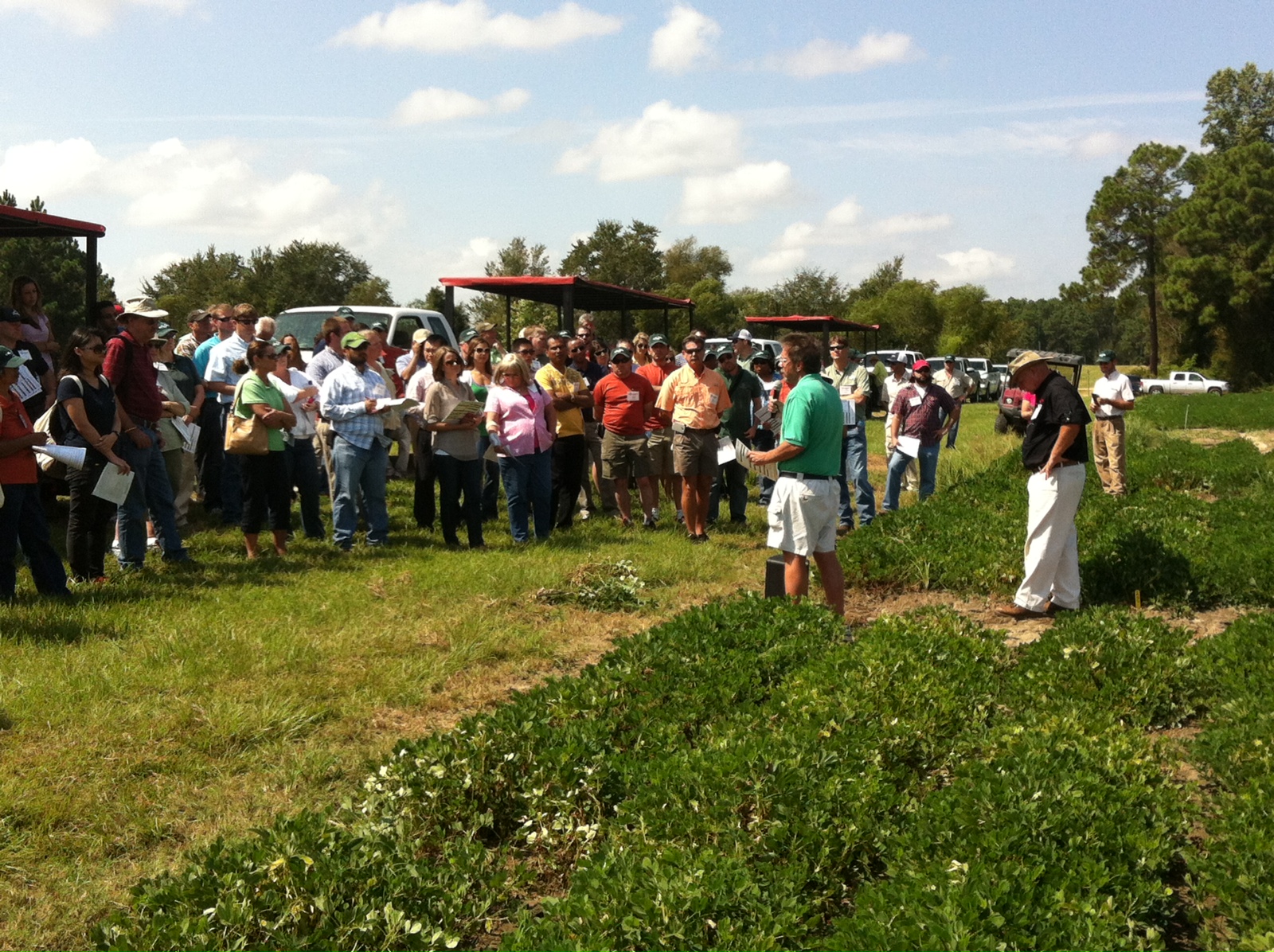 All topics during this stop included discussion of planting, harvesting and crop development by Dr. John Beasley; nematode management and early season fungicide application by Dr. Bob Kemerait; information on the USDA-ARS breeding program by Dr. Corley Holbrook; peanut insect management research by Dr. Mark Abney; weed science and nutsedge issues in peanuts by Dr. Timothy Grey; foliar diseases in peanuts by Dr. Albert Culbreath; thrips and transmission of tomato spotted wilt virus by Dr. Babu Srinivasan; and peanut agronomic research by Dr. Scott Tubbs.
All topics during this stop included discussion of planting, harvesting and crop development by Dr. John Beasley; nematode management and early season fungicide application by Dr. Bob Kemerait; information on the USDA-ARS breeding program by Dr. Corley Holbrook; peanut insect management research by Dr. Mark Abney; weed science and nutsedge issues in peanuts by Dr. Timothy Grey; foliar diseases in peanuts by Dr. Albert Culbreath; thrips and transmission of tomato spotted wilt virus by Dr. Babu Srinivasan; and peanut agronomic research by Dr. Scott Tubbs.
Attendees also had the opportunity try some of Tyron Spearman’s famous grilled peanut butter and jelly sandwiches at the Gibbs Farm stop. Tyron is with the National Peanut Buying Points Association and usually has the chance to share some of his grilled pb&js each year on the tour. According to Tyron, the key to making a great grilled pb&j is to mix your peanut butter and jelly before spreading it on your bread. Definitely a great twist on the original peanut butter and jelly sandwich!
Colquitt County Ag Update
While at Sunbelt this morning, peanut tour attendees were able to hear a crop update on Colquitt County from Dr. John Beasley and Colquitt County extension agent, Matt Roberts. Below is an outline of the update from Roberts.
- Overall crop condition is good to very good, even after a rough start with cool conditions at planting, early Thrips pressure, and wet growing season. Things could certainly be worse right now.
- We have seen a huge acreage drop this year as we should have….went from probably an all time high or close to it of nearly 23000 to just a little more than 15000 about where we usually are. This was around 35% decease in acreage and still below the state average.
- Not sure on the price situation but i don’t foresee yield being anywhere close to last year’s numbers.
- We have run alot of maturity samples in the past week. Late April and very early May planted peanuts are running about 145 to 150 days. Later planted peanuts are running around 140 days. Looks like the crop is going to be ready all about the same time.
- There will be a good many dug in the next week or so.
- We have had a few growers dig and harvest. Grades have been in the low to mid 70s.
- Diseases have not been all that terrible this year. TSWV has maybe been a little worse than the past few years, especially on larger plants. Leaf spot and white mold have ramped up in the past weeks. If growers were more than two weeks from digging according to the profile board and a week or two from their last fungicide spray, we have recommended another application to get them through to harvest.
Sunbelt Agricultural Exposition: UGA researchers are taking things a step higher with UAVs
The first stop of the 27th annual Georgia Peanut Tour was the Sunbelt Agricultural Exposition in Moultrie, Ga. Many of you may be familiar with the annual expo that takes place at Sunbelt each October. This facility is not only the home to one of the largest farm shows in the country, it is also home to a 600 acre research farm. At Sunbelt, Dr. John Beasley and Dr. Glenn Harris with the University of Georgia, demonstrated their research related to the use of unmanned aerial vehicles (UAVs) supported by the Georgia Peanut Commission, Georgia Cotton Commission, Georgia Centers of Innovation for Aerospace and Agribusiness, as well as the Sunbelt Ag Expo, University of Georgia Tifton Campus and Middle Georgia State College. Their project’s primary focus is on detecting pests, irrigation needs, diseases and nutrition issues in peanuts earlier in the production process.This early detection becomes a huge benefit to crops as it can help prolong the life of crops, better-manage pesticide applications, as well as maximize yields and profits. The Association for Unmanned Vehicle Systems expects the unmanned aircraft systems industry to grow by leaps in bounds in the upcoming years, and believes agriculture is the largest potential sector for UAVs to be used. Check out this video demonstration of the UAV in action.
2013 Georgia Peanut Tour set for Sept. 17-19 in Valdosta, Ga.
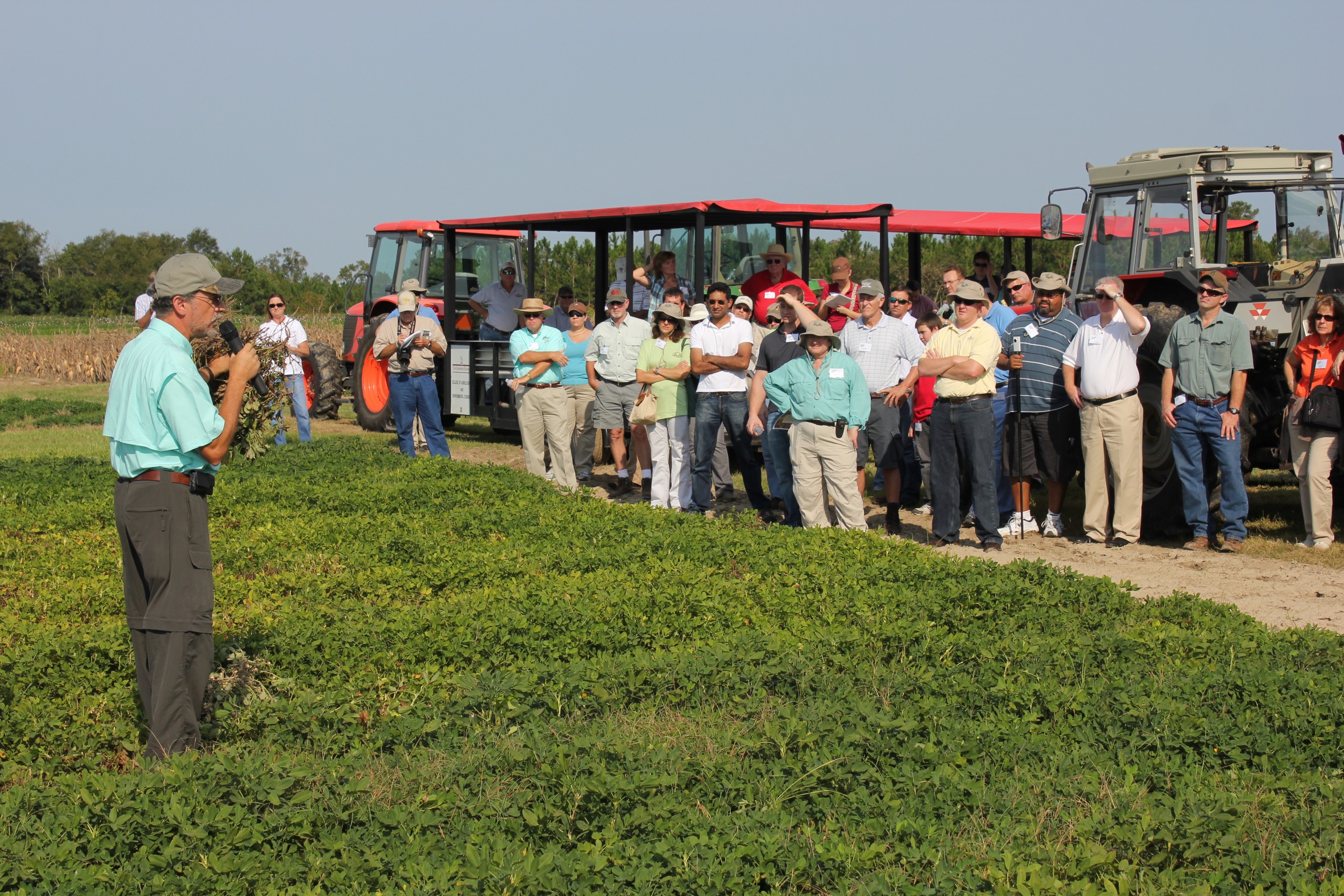 The 27th annual Georgia Peanut Tour will be held Sept.18-19, 2013, and centrally located out of Valdosta, Ga., at the Fairfield Inn & Suites. The tour begins at 8 a.m. Wednesday, Sept. 18, and will end on Thursday, Sept. 19, at approximately 9:30 p.m. Tour stops will be made in several peanut-producing counties including Brooks, Lowndes and Lee Co., Fla. Attendees can expect to see first-hand many aspects of peanut production in the state of Georgia throughout the tour. This year’s tour is a host to many interesting and educational stops including on-farm harvest demonstrations, local crop consultant news updates and several special highlights including: Birdsong Peanuts in Lee, Fla.; Kelley Manufacturing Co. in Tifton; R.L. Cunningham & Sons in Quitman; and DuPont Crop Protection in Valdosta. Other stops will include the Georgia Department of Agriculture lab and Federal-State Inspection Service offices, both in Tifton, as well as research stops at the University of Georgia Tifton Campus’ Gibbs Farm and the Darrell Williams Research Farm at the Sunbelt Agricultural Expo grounds in Moultrie.
The 27th annual Georgia Peanut Tour will be held Sept.18-19, 2013, and centrally located out of Valdosta, Ga., at the Fairfield Inn & Suites. The tour begins at 8 a.m. Wednesday, Sept. 18, and will end on Thursday, Sept. 19, at approximately 9:30 p.m. Tour stops will be made in several peanut-producing counties including Brooks, Lowndes and Lee Co., Fla. Attendees can expect to see first-hand many aspects of peanut production in the state of Georgia throughout the tour. This year’s tour is a host to many interesting and educational stops including on-farm harvest demonstrations, local crop consultant news updates and several special highlights including: Birdsong Peanuts in Lee, Fla.; Kelley Manufacturing Co. in Tifton; R.L. Cunningham & Sons in Quitman; and DuPont Crop Protection in Valdosta. Other stops will include the Georgia Department of Agriculture lab and Federal-State Inspection Service offices, both in Tifton, as well as research stops at the University of Georgia Tifton Campus’ Gibbs Farm and the Darrell Williams Research Farm at the Sunbelt Agricultural Expo grounds in Moultrie.
Another highlight of the tour will include an Early Bird “Hot Topics” Seminar on Tuesday, Sept. 17, beginning at 3 p.m. The “Hot Topics” Seminar, also held at the Fairfield Inn & Suites, will feature topics on the economic sustainability of U.S. peanut farms, global and U.S. peanut markets and opportunities, as well as a current crop update.
The Georgia Peanut Tour is coordinated by the Georgia Peanut Commission, the University of Georgia Griffin and Tifton Campuses and the USDA/ARS National Peanut Research Lab.
Register by visiting www.gapeanuts.com or for more information, email dana@gapeanuts.com.
It’s A Wrap
The 26th Annual Georgia Peanut Tour concluded Thursday evening with another wonderful Southern meal. The tour is known for it’s Southern hospitality and great food! Thursday night was no exception to the rule. After a full day of tours the attendees were treated to a wonderful meal at Southern Woods Plantation. This picturesque setting was fitting for the final evening on the tour as new found friends were able to join together for a porkchop meal, potatoe casserole, green beans and wonderful desserts. The tour would not be the same without new attendees and those that have attended all 26 Peanut Tours.
However, this year we had the youngest attendee ever on the Peanut Tour. His name is Scott and he is the 3-month old son of Adam and Amanda Smith. Amanda is an ag economist with the University of Georgia. Scott enjoyed his first peanut tour and he even got to sit in a plane at Thrush Aircraft.
It’s a Flat Mr. Peanut
Ever heard of Flat Stanley? Many of you may have received one in the mail from a child asking you to take a photo of yourself with the Flat Stanley and then mail it back to the school with information about where you live. The children are then able to learn all about various cities, careers and places to visit across the U.S. New this year on the Georgia Peanut Tour was a “Flat Mr. Peanut.” He was brought to us by Lyndsay Bashore, associate scientist with Kraft Foods. Everyone enjoyed having their photo taken with Mr. Peanut on the last night of the tour. Check out some of the photos below.

